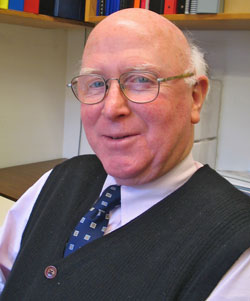Alan Astbury facts for kids
Quick facts for kids
Alan Astbury
FRS FRSC
|
|
|---|---|
 |
|
| Born | November 27, 1934 |
| Died | July 21, 2014 (aged 79) |
| Alma mater | University of Liverpool |
| Known for | TRIUMF W particle |
| Awards | Rutherford Medal and Prize |
| Scientific career | |
| Fields | Physics |
| Institutions |
|
Alan Astbury (1934–2014) was a Canadian physicist. A physicist is a scientist who studies how the universe works. He was a professor at the University of Victoria and led the Tri-Universities Meson Facility (TRIUMF) laboratory.
Contents
Early Life and School
Alan Astbury was born in Crewe, England. His mother worked in a bakery and his father was an engineer. Alan went to Nantwich and Acton Grammar School.
He was good at sports like cricket and football. He even played football for Crewe Schoolboys with a famous player, Frank Blunstone. But his parents wanted him to focus on his studies instead of a sports career.
A Career in Physics
In 1953, Alan Astbury started studying at the University of Liverpool. He earned a top degree in 1956 and then a PhD in 1959. A PhD is a very high university degree.
He received a special research grant to work on a large particle accelerator. This machine was called a synchrocyclotron. It was the second-largest in the world at that time. His team studied tiny particles called muons. They confirmed an important physics rule about how these particles behave.
Working at Big Labs
In 1961, Alan joined a group at Berkeley, California. There, he used another large particle accelerator. He worked on a special tool to measure the weight of tiny particles very accurately.
In 1963, he moved to the new Rutherford Appleton Laboratory (RAL) in England. This lab had a powerful particle accelerator called Nimrod. At RAL, he and his team confirmed another important physics rule. This rule was about how certain particles, called kaons, decay.
For many years, RAL worked with other universities on different experiments. They studied various forces between particles. They also did experiments with tiny particles called antiprotons and protons at CERN. CERN is a huge science lab in Switzerland where scientists study the smallest parts of matter.
Discovering New Particles
In 1977, Alan Astbury's group joined a big team at CERN called UA1. They worked with a famous scientist named Carlo Rubbia. A large machine at CERN, the Super Proton Synchrotron, was changed into a "collider." This machine smashes particles together at very high speeds.
The British team built a big detector to measure these particles. Alan Astbury and Carlo Rubbia became the main leaders for the UA1 project. Their work helped confirm the existence of a special particle called the W particle. This discovery was so important that Carlo Rubbia and another scientist, Simon van der Meer, won a Nobel Prize.
Leading Science in Canada
Later, Alan Astbury became a professor at the University of Victoria in Canada. He received a lot of money for his research. In 1994, he became the director of TRIUMF. TRIUMF is Canada's national particle accelerator laboratory.
He helped Canada get more involved in projects at CERN. This included contributing to the Large Hadron Collider ATLAS experiment. The Large Hadron Collider is the world's largest and most powerful particle accelerator.
From 2005 to 2008, Alan Astbury was the president of the International Union of Pure and Applied Physics (IUPAP). He helped bring in new members and started an award for young scientists. He also worked to get more women involved in science leadership roles.
Alan Astbury passed away in 2014. He is remembered for his important contributions to physics and for leading major scientific projects.
Honours and Awards
- 2002 CAP Medal for Lifetime Achievement in Physics
- 1986 Rutherford Medal and Prize
- 1988 Elected a Fellow of the Royal Society of Canada (FRSC)
- 1993 Elected a Fellow of the Royal Society (FRS)

